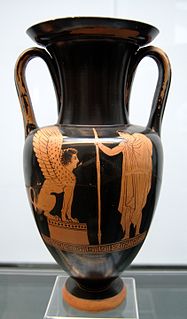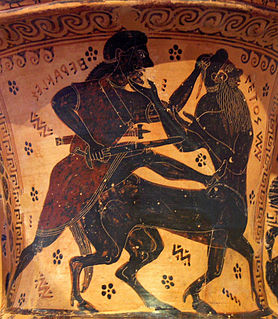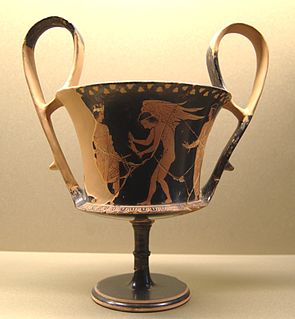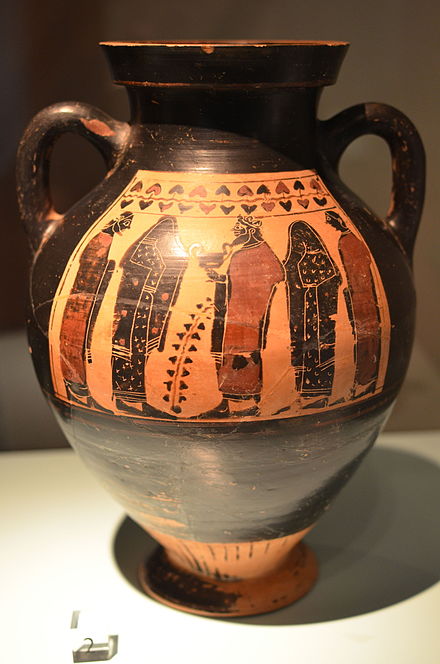
Black-figure pottery painting, also known as the black-figure style or black-figure ceramic is one of the styles of painting on antique Greek vases. It was especially common between the 7th and 5th centuries BC, although there are specimens dating as late as the 2nd century BC. Stylistically it can be distinguished from the preceding orientalizing period and the subsequent red-figure pottery style.

Exekias was an ancient Greek vase-painter and potter who was active in Athens between roughly 545 BC and 530 BC. Exekias worked mainly in the black-figure technique, which involved the painting of scenes using a clay slip that fired to black, with details created through incision. Exekias is regarded by art historians as an artistic visionary whose masterful use of incision and psychologically sensitive compositions mark him as one of the greatest of all Attic vase painters. The Andokides painter and the Lysippides Painter are thought to have been students of Exekias.

Red-figure vase painting is one of the most important styles of figural Greek vase painting.

Sophilos was an Attic potter and vase painter in the black-figure style. Sophilos is the oldest Attic vase painter so far to be known by his true name. Fragments of two wine basins ('’dinoi’’) in Athens are signed by him, indicating that he both potted and painted them. In total, 37 vessels are ascribed to him, mostly amphorae, '’dinoi’’, kraters, as well as three pinakes. Apart from his work for the domestic market, he was also one of the masters of major significance in the process of supplanting the dominance of Corinthian vase painting in the markets of Etruria, and Southern Italy, the most important export area for Greek vases. His works were exported as far as the Black Sea region, Syria and Egypt (Naukratis). He was one of the first painters to use additional colours at a grand scale, thus increasing the optical and artistic distinction between Corinthian and Attic vase painting. While he was conservative and traditionalist in terms of the ornamentation and animal figures he used, his intervening figural scenes, mostly of mythological motifs, were entirely innovative. He broke up established standard scenes, had figures act individually, and found clever and unconventional new ways of structuring the narrative. As his artistic style progressed, he increasingly pushed ornamental designs into the margin, as his figural scenes became more and more important. Stylistically, his work is close to that of the late Gorgon painter, whose style he developed further, to be continued later by Klitias, and culminate in the François vase. In spite of his innovative pictorial compositions and his talent to constantly invent new scenes; his drawing style was usually not very accurate. The overall impact of his works is hardly diminished by that.

Euphronios was an ancient Greek vase painter and potter, active in Athens in the late 6th and early 5th centuries BC. As part of the so-called "Pioneer Group,", Euphronios was one of the most important artists of the red-figure technique. His works place him at the transition from Late Archaic to Early Classical art, and he is one of the first known artists in history to have signed his work.

The Achilles Painter, was a vase-painter active ca. 470–425 BC. His name vase is an amphora, Vatican 16571, in the Vatican museums depicting Achilles and dated 450–445 BC. An armed and armored Achilles gazes pensively to the right with one hand on his hip. The other hand holds a spear. On the opposite surface a woman performs libation.

The Berlin Painter is the conventional name given to an Attic Greek vase-painter who is widely regarded as a rival to the Kleophrades Painter, among the most talented vase painters of the early 5th century BCE.

Douris or Duris was an ancient Athenian red-figure vase-painter and potter active c. 500 to 460 BCE.

Lydos was an Attic vase painter in the black-figure style. Active between about 560 and 540 BC, he was the main representative of the '’’Lydos Group’’’. His signature, ό Λυδός, ho Lydos, the Lydian, inscribed on two vases, is informative regarding the cultural background of the artist. Either he immigrated to Athens from the Lydian empire of King Kroisos, or he was born in Athens as the son of Lydian parents. In any case, he learned his trade in Athens.

Psiax was an Attic vase painter of the transitional period between the black-figure and red-figure styles. His works date to circa 525 to 505 BC and comprise about 60 surviving vases, two of which bear his signature. Initially he was allocated the name Menon Painter by John Beazley. Only later was it realised that the artist was identical with the painters signing as Psiax.

The Brygos Painter was an ancient Greek Attic red-figure vase painter of the Late Archaic period. Together with Onesimos, Douris and Makron, he is among the most important cup painters of his time. He was active in the first third of the 5th century BCE, especially in the 480s and 470s BCE. He was a prolific artist to whom over two hundred vases have been attributed, but he is perhaps best known for the Brygos Cup, a red-figure kylix in the Louvre which depicts the "iliupersis" or sack of Troy.
The Acheloos Painter, active around 525 - 500 BCE in Athens, was a vase painter of the black-figure style. His scenes were like those of the Leagros Group; however, unlike their work, his themes are comic episodes, like modern cartoons. Herakles was a favorite topic, as were banqueting scenes. His banqueters were portrayed satirically: overweight, aging, huge, jutting noses, and so on. The heroic is made anti-heroic by parody. His preferred vase forms are amphorae and hydriae.

The Nessos Painter, also known as Netos or Nettos Painter, was a pioneer of Attic black-figure vase painting. He is considered to be the first Athenian to adopt the Corinthian style who went on to develop his own style and introduced innovations. The Nessos Painter is often known to be one of the original painters of black-figure. He only worked in this style, which is shown on his name vase in the National Archaeological Museum in Athens. Most of the known Nessos Painter ceramics were found in funerary settings such as cemeteries and mortuaries.

The Amasis Painter was an ancient Greek vase painter who worked in the black-figure technique. He owes his name to the signature of the potter Amasis, who signed 12 works painted by the same hand. At the time of the exhibition, "The Amasis Painter and His World" (1985), 132 vases had been attributed to this artist.

The Pan Painter was an ancient Greek vase-painter of the Attic red-figure style, probably active c. 480 to 450 BCE. John Beazley attributed over 150 vases to his hand in 1912:
"Cunning composition; rapid motion; quick deft draughtsmanship; strong and peculiar stylisation; a deliberate archaism, retaining old forms, but refining, refreshing, and galvanizing them; nothing noble or majestic, but grace, humour, vivacity, originality, and dramatic force: these are the qualities which mark the Boston krater, and which characterize the anonymous artist who, for the sake of convenience, may be called the 'master of the Boston Pan-vase', or, more briefly, 'the Pan-master'."

The Shuvalov Painter was an Attic vase painter of the red-figure style, active between 440 and 410 BC, i.e. in the High Classical period.

The Foundry Painter was an ancient Greek Attic red-figure vase painter of the Late Archaic period. His real name is unknown; the conventional name is derived from his most famous work, the Berlin Foundry Cup.

The Oreithyia painter was an ancient Greek red-figure vase painter who flourished from 470–460 BCE. He is one of the many painters of the red-figure Classical Period, but his work is not considered the finest or well-known. This is partly because he began painting during the transition from red-figure to black-figure pottery.
The Tithonos Painter is the conventional name given to an Attic Greek red-figure vase-painter whose actual name never appeared on his works, which have been recognized in the 20th century when John Beazley identified his Late Archaic characteristic house style. Pots with decoration attributed to the Tithonos Painter are all Nolan amphorae and lekythoi. He has been characterized as "a competent but unoriginal craftsman", working under the influence of the Berlin Painter.

The Lysippides Painter was an Attic vase painter in the black-figure style. He was active around 530 to 510 BC. His real name is not known.


















